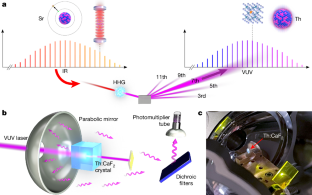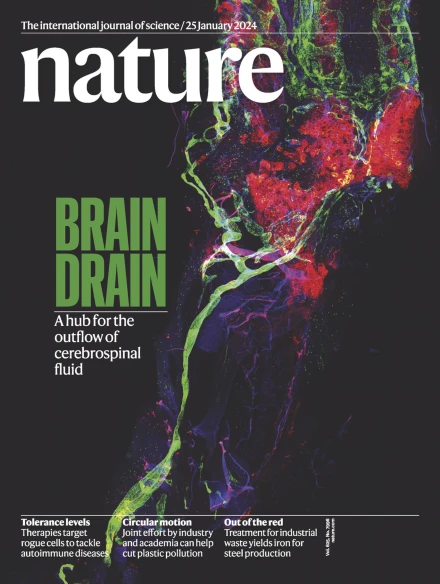229mTh 核异构转变和 87Sr 原子钟的频率比
IF 50.5
1区 综合性期刊
Q1 MULTIDISCIPLINARY SCIENCES
引用次数: 0
摘要
光学原子钟1,2 利用电子能级来精确记录时间。基于核能级的时钟有望成为精密计量和基础物理学研究的下一代平台。钍-229 核显示出独特的低能核转变,在最先进的真空紫外(VUV)激光光源可及的范围内,因此被提议用于建造核钟3,4。然而,目前尚未对 229mTh 异构体进行量子态分辨光谱分析,以确定其基本核结构,并建立与现有原子钟的直接频率联系。在这里,我们使用紫外线频率梳直接激发固态 CaF2 主材料中的窄 229Th 核时钟跃迁,并确定绝对跃迁频率。我们将基频梳稳定在 JILA 87Sr 时钟2 上,并利用飞秒增强腔将基频相干上转换为其在紫外范围内的七次谐波。这种紫外梳在核能级和电子能级之间建立了频率联系,使我们能够直接测量 229Th 核时钟跃迁和 87Sr 原子钟的频率比。我们还精确测量了核四极分裂,并提取了异构体的内在特性。这些结果标志着基于核的固态光学时钟的开始,并展示了我们所知的用于基础物理研究的核时钟和原子钟的首次比较。这项工作代表了精密计量学、超快强场物理学、核物理和基础物理学的融合。本文章由计算机程序翻译,如有差异,请以英文原文为准。


Frequency ratio of the 229mTh nuclear isomeric transition and the 87Sr atomic clock
Optical atomic clocks1,2 use electronic energy levels to precisely keep track of time. A clock based on nuclear energy levels promises a next-generation platform for precision metrology and fundamental physics studies. Thorium-229 nuclei exhibit a uniquely low-energy nuclear transition within reach of state-of-the-art vacuum ultraviolet (VUV) laser light sources and have, therefore, been proposed for construction of a nuclear clock3,4. However, quantum-state-resolved spectroscopy of the 229mTh isomer to determine the underlying nuclear structure and establish a direct frequency connection with existing atomic clocks has yet to be performed. Here, we use a VUV frequency comb to directly excite the narrow 229Th nuclear clock transition in a solid-state CaF2 host material and determine the absolute transition frequency. We stabilize the fundamental frequency comb to the JILA 87Sr clock2 and coherently upconvert the fundamental to its seventh harmonic in the VUV range by using a femtosecond enhancement cavity. This VUV comb establishes a frequency link between nuclear and electronic energy levels and allows us to directly measure the frequency ratio of the 229Th nuclear clock transition and the 87Sr atomic clock. We also precisely measure the nuclear quadrupole splittings and extract intrinsic properties of the isomer. These results mark the start of nuclear-based solid-state optical clocks and demonstrate the first comparison, to our knowledge, of nuclear and atomic clocks for fundamental physics studies. This work represents a confluence of precision metrology, ultrafast strong-field physics, nuclear physics and fundamental physics. A vacuum ultraviolet frequency comb is used to directly excite the narrow 229Th nuclear clock transition in a solid-state CaF2 host material, marking the start of nuclear-based solid-state optical clocks.
求助全文
通过发布文献求助,成功后即可免费获取论文全文。
去求助
来源期刊

Nature
综合性期刊-综合性期刊
CiteScore
90.00
自引率
1.20%
发文量
3652
审稿时长
3 months
期刊介绍:
Nature is a prestigious international journal that publishes peer-reviewed research in various scientific and technological fields. The selection of articles is based on criteria such as originality, importance, interdisciplinary relevance, timeliness, accessibility, elegance, and surprising conclusions. In addition to showcasing significant scientific advances, Nature delivers rapid, authoritative, insightful news, and interpretation of current and upcoming trends impacting science, scientists, and the broader public. The journal serves a dual purpose: firstly, to promptly share noteworthy scientific advances and foster discussions among scientists, and secondly, to ensure the swift dissemination of scientific results globally, emphasizing their significance for knowledge, culture, and daily life.
 求助内容:
求助内容: 应助结果提醒方式:
应助结果提醒方式:


